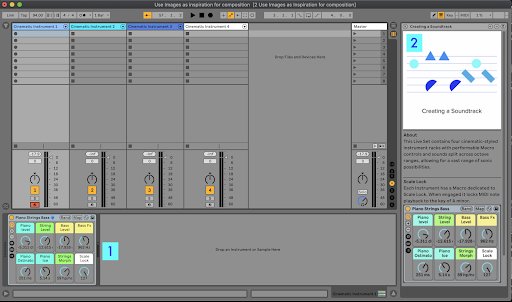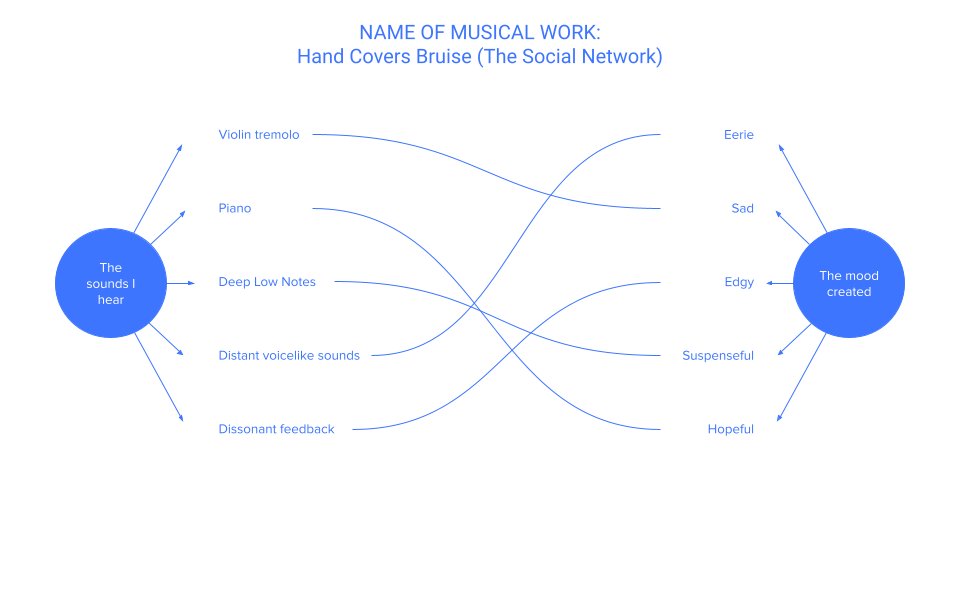
Lesson overview
In this lesson, students identify and analyze sounds used by film composers. Students then use imagery as a stimulus to compose and record short musical ideas using the included Use Images as inspiration for Composition - Live Set.
Learning intentions
- Critical listening – identify and describe musical conventions
- Technology literacy – effective use of MIDI recording and editing
- Creativity – imagine musical responses to imagery
Preparation (10 mins)
In the classroom (50-90 mins)
- Step 1: Introduction – watch examples of the same movie clip paired with different soundtracks (5-10mins)
- Step 2: Listening task – students listen to, analyse and discuss music using a mind mapping tool to make connections between music and mood evocation (10-15 mins)
- Step 3: Practical task – using the Use Images as Inspiration for Composition Live Set, and the linked websites, students choose images as a stimulus to compose and record* short musical works into Live’s Arrangement View (15-30 mins)
- Step 4: Wrap up – students export and share their musical ideas (5-10 mins)
Activity Option:
* Allow additional teaching time on recording and editing MIDI if your students are not experienced with these.

Introduction: The impact and function of music in film
This lesson aims at getting students to identify the extensive role that music plays in shaping the tone and mood of a film.
The videos below offer a fun way to introduce the impact and function of music within a scene.
How Music Affects Film #3
This video overdubs a variety of different film music scores over the top of a classic scene from The Shining.
Q. How does the mood of the scene change with each musical change?
How Music Affects Film #8
Another mashup of a variety of classic film soundtracks to the famous standoff scene in The Good, the Bad and the Ugly.
Q. If you were to pick a different score from the original, which would it be? Why?

Listening Task: Connecting music and mood
In this listening exercise, students listen to the provided soundtracks and use mind maps as a means to examine and build insights and connections between music and mood.
"The mind-mapping template provides a structure for students to analyse and identify links between sound types and evocation of mood" — Matt Ridgway
When listening to the examples provided below, students can:
- Identify and name each of the sounds and instruments
- Identify the mood or feeling that the sounds evoke
- Explain the connection between the sounds and the mood it evokes
- Provide theories as to why the composer has chosen and used sounds in the way they did
Goal:
- Equip students to use musical vocabulary and develop opinions on how composers utilize sound and music to evoke a mood.
Atticus Ross and Trent Reznor’s soundtrack to The Social Network
Atticus Ross and Trent Reznor’s soundtrack to The Social Network has a range of intriguing and evocative sounds.
“Hand Covers Bruise” (the first track) is an example of how slow, subtle movements can evolve and build over time.
Q. How does the sound move over time?
Tip: This piece is a slow-builder. If students can’t hear the subtle movement, try jumping the playhead within the first three minutes, then ask them to identify how the sound is different.
Hildur Guðnadóttir’s score for Joker
Award-winning Icelandic composer Hildur Guðnadóttir’s score for Joker is dark and brooding. This piece demonstrates the effectiveness of combining just a couple of musical elements.
Q. How many sounds can you hear in this?
Tip: The goal here is to get students to understand how only a couple of minimal musical elements can evoke a feeling of menace. Less is More here.
Biking to School from Stranger Things Soundtrack
“Biking to School” from Kyle Dixon and Michael Stein’s Stranger Things soundtrack is a brighter, happier piece of music.
Q. What mood is created by this piece? Which sounds make it bright and happy?
Tip: Ask students to imagine a scene that is occurring when this music is playing.
Classroom Tip: Mind map to draw lines between mood and sound
For the listening task, ask students to use a mind map to identify and name each of the sounds and instruments, as well as consider and name the mood or feeling of the music. They can then draw lined connections between each sound and the mood that it evokes.
Completed Mind Map Example
Use this completed mind map example to demonstrate use to students
Mind Map - Blank Template
This is an interactive Google Drawing document that you may tell your students to duplicate and use to create their own digital mind map.
Alternatively, under File > Download you find options to save the template in other file formats to share with your students, or you can simply print it and hand it out.
Worksheet: Mind Map (listening exercise) - Blank Template
Google Drawings
Learn more about Google Drawings:

Practical Task: Using images as inspiration for composition
Working independently or in pairs, students use imagery as a stimulus to compose and record short musical ideas. They work with the instruments in the Cinematic Instrument Racks Live Set to develop musical ideas that match the mood the imagery evokes.
Task steps:
- The teacher demonstrates and explains how to use the Cinematic Instrument Racks
- Students choose from the Visual Resources and identify the mood their chosen image conveys
- Students explore the included Cinematic Instrument Racks and create a short musical response to their chosen image
- Students record and overdub MIDI into Live’s Arrangement View
- Students export and share work with their classmates
“The mood or feeling an image can convey is something that young people can identify. Discerning which sounds may match the mood of an image signifies an excellent starting point for young composers.” — Matt Ridgway
Recording MIDI and Automation into Live’s Arrangement
In this task, MIDI instruments may be recorded in a single take via a MIDI controller. Additional parts can then be overdubbed to create a layered composition.
This guide provides step-by-step instructions on how to record and overdub into Live’s Arrangement View.
Guide: Recording MIDI and Automation into Live’s Arrangement View
Use Images as Inspiration for Composition - Live Set
This downloadable Live Set contains four cinematic-styled instrument racks with performable Macro controls and sounds split across octave ranges, allowing for a vast range of sonic possibilities.
Download: Use Images as Inspiration for Composition - Live Set

- Four cinematic-styled instrument racks with performable Macro controls
- Overview of what is included within the Live Set
Visual Resources: Evocative and Inspiring Images
These websites contain collections of evocative and inspiring images that your students can use to inspire their compositions. Select some in advance, or let your students choose for themselves.
National Geographic
These landscape images from National Geographic may evoke an expansive musical response from students.
Erik Johansson
This collection of surreal photographic images by photographer Erik Johansson may spark an imaginative and whimsical musical response.
deMilked
Photographer Mikko Lagerstedt’s work captures otherworldly locations in Finland, and could easily be on a film poster.
shutterstock
This collection of spooky forest images may be suitable for darker, scarier musical responses.

Delve Deeper: Cinematic sounds
There are many cinematic sounds available to download if you want to have an extended sound palette available.
Project Sam
The Free Orchestra by Project Sam provides a collection of free cinematic Kontakt libraries.
Spitfire audio
Spitfire audio provides an excellent collection of film scoring sounds via their free LABS virtual instrument.
Cinematic Live Packs
There are many more cinematic instruments and samples available at Ableton’s website.


